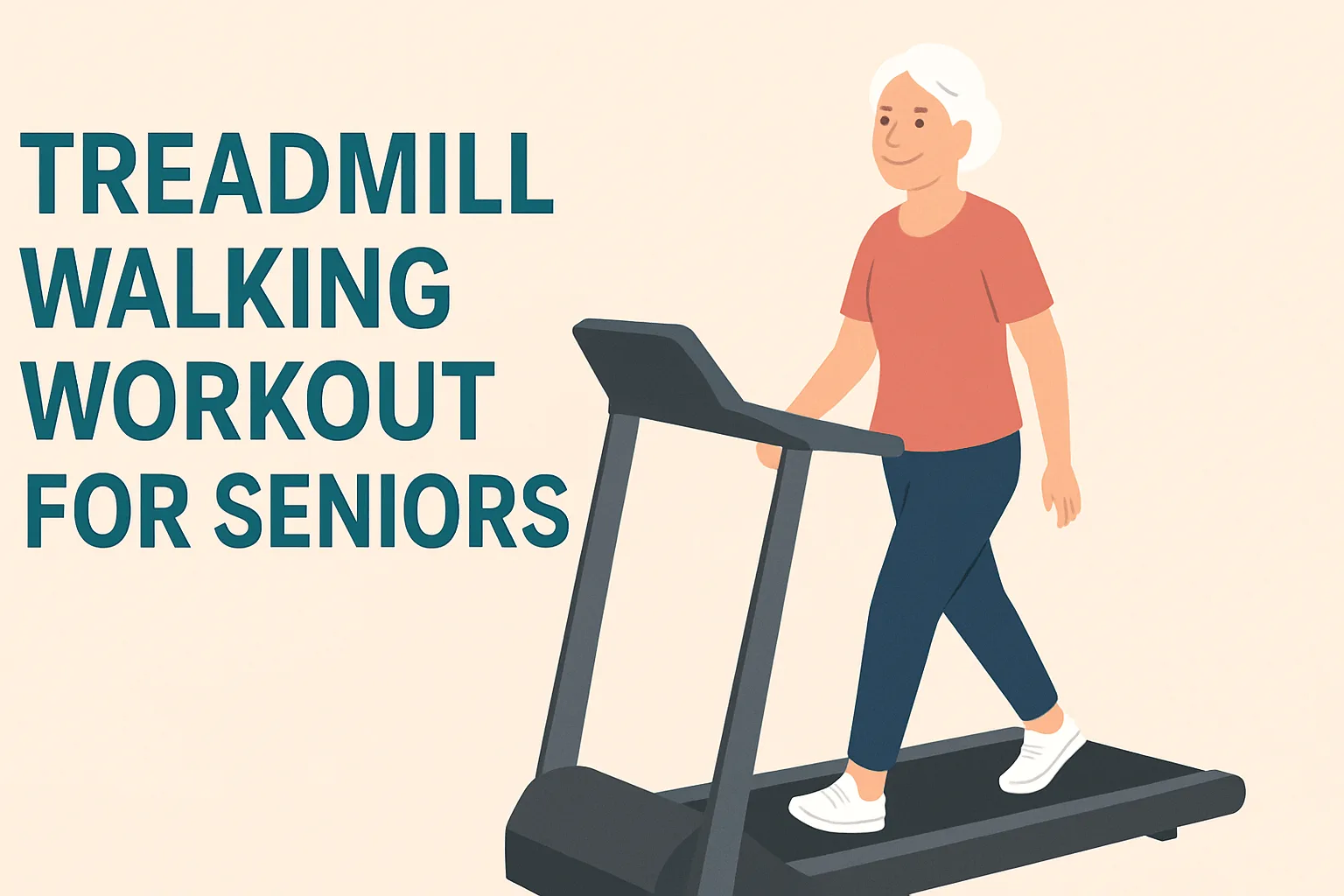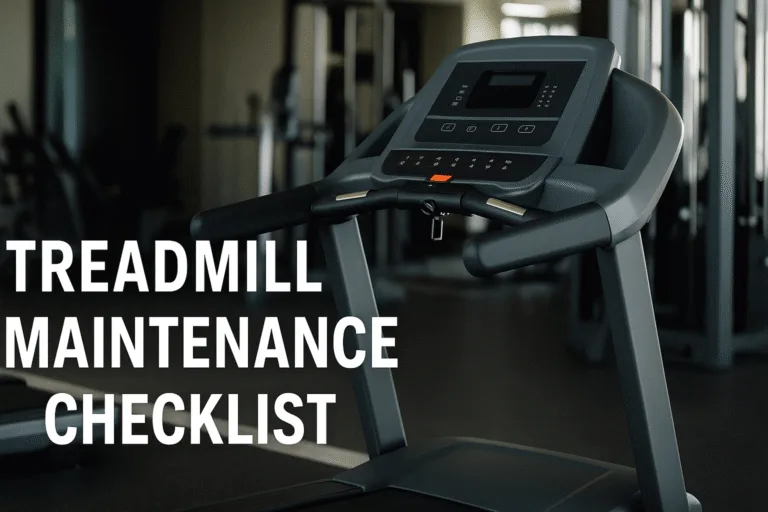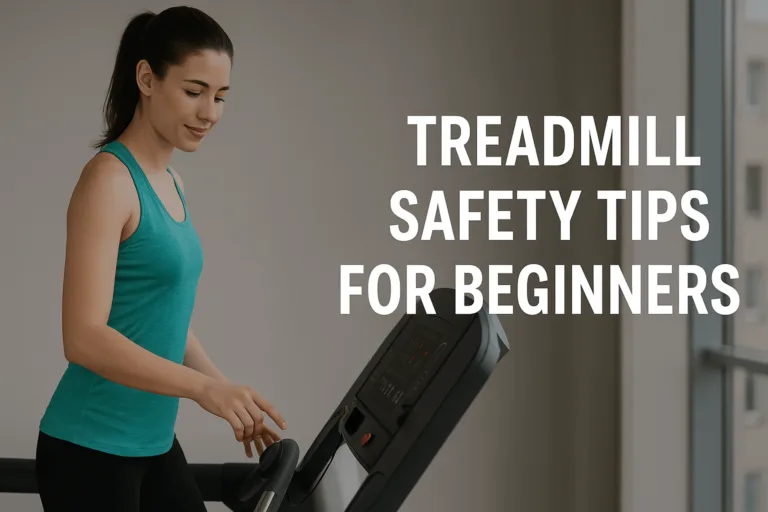Running offers numerous advantages, but using a treadmill is an excellent way to begin your fitness journey, especially if you prefer not to run outside. It creates a safe and controlled environment, facilitating a focus on enhancing endurance and refining running technique.
Unlike outdoor running, treadmills allow you to modify the speed and incline to suit your fitness level, which helps lower the risk of injury.
If you’re new to treadmill running, it’s super important to focus on using the right technique and gradually increasing your intensity. You might be wondering how to run on a treadmill, right?
In this friendly beginner’s guide, we’ll walk you through every step of the process, covering everything from proper setup to avoiding typical mistakes. By following these tips, you’ll build confidence and enjoy an effective workout while minimizing strain on your body.
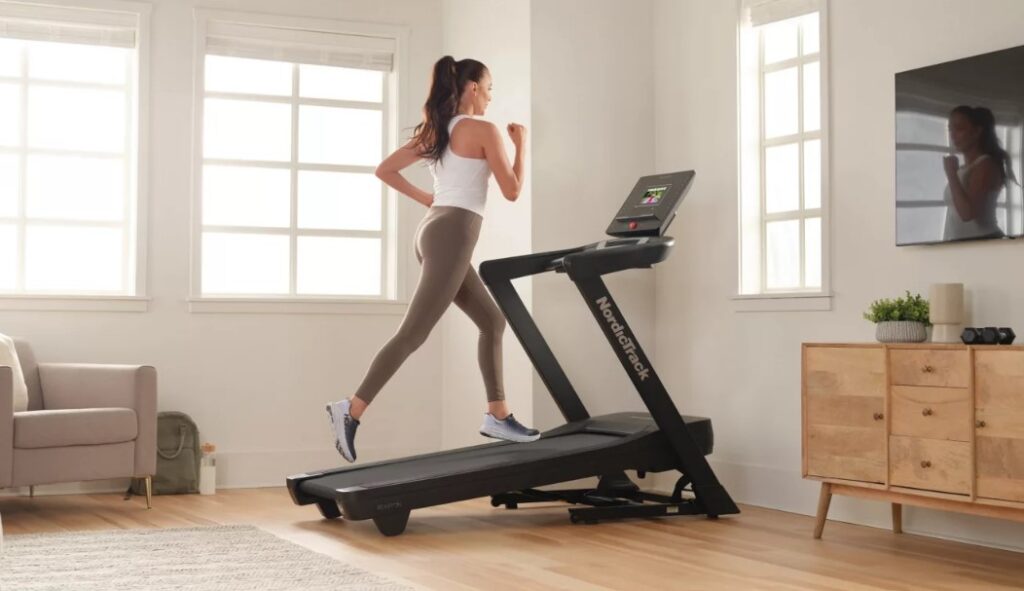
Table of Contents
How Should You Prepare for Your Treadmill Workout?
If you’re new to treadmill running, taking the proper steps before you start will help you avoid injuries, improve performance, and make your workout more enjoyable. Whether you’re using a treadmill at home or in the gym, proper preparation is key.
Proper Running Shoes
Wearing suitable running gear enhances comfort and reduces the chances of blisters, pain, and injuries. Choose cushioned shoes that provide adequate arch support. Even though treadmills have shock absorption, we suggest using appropriate footwear because it is crucial to protect your joints.
Comfortable Workout Clothes
Choose lightweight, breathable fabrics designed to wick away moisture. While tight-fitting clothes can reduce chafing, loose garments may snag on the treadmill. We suggest utilizing moisture-wicking materials such as polyester or nylon, as they are great options.
Towel and Water Bottle
Exercising outside can cause you to sweat heavily, similar to working out on a treadmill. Therefore, keep a small towel close by to wipe sweat from your face and hands. It’s also important to have a water bottle nearby to maintain hydration, especially during extended workouts. Many treadmills come equipped with bottle holders for convenient bottle placement.
Wireless Earphones or Music Devices
I always wear my wireless earphones because they enhance my treadmill running experience, allowing me to enjoy music or podcasts. Wireless earphones are also perfect because they eliminate tangled cords, which can be distracting.
Fitness Tracker or Smartwatch (Optional)
A fitness tracker helps monitor your heart rate, step count, and the calories you burn. While not essential, it acts as a great motivational tool for tracking progress and setting goals. I prefer using it because it keeps me on top of my objectives.
How Can Beginners Run on a Treadmill Step by Step?
1. Warm Up Before You Start Running
Warming up before you hop on the treadmill is such an important step! It prepares your muscles, boosts your blood flow, and helps lower the chance of injury. Plus, a good warm-up makes it easier for your body to shift from resting to moving smoothly.
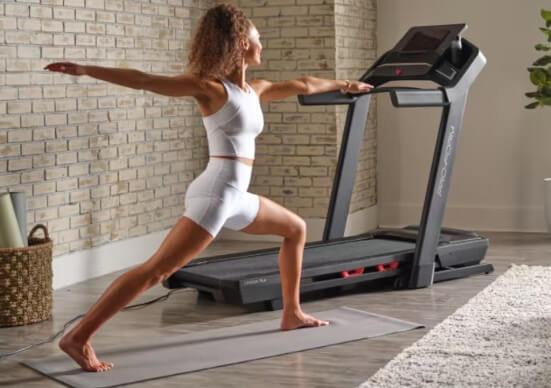
How to Warm Up for Treadmill Running
- Begin with a gentle walk: Adjust the treadmill speed to 2.5–3.5 mph and walk for 5–10 minutes to loosen your legs and enhance circulation.
- Slowly elevate your speed: After several minutes, raise your pace to 3.5–4.5 mph for a brisk walk to engage your leg muscles.
- Incorporate dynamic stretches: Step away from the treadmill to perform light leg swings, high knees, or butt kicks for a more thorough warm-up muscles.
- Before running, include mobility exercises such as arm circles, shoulder rolls, and ankle rotations to enhance flexibility and coordination.
Why Warm-Up is Important
- It helps prevent muscle strains and injuries.
- It enhances oxygen flow, making it easier to breathe while running.
- It gets your heart and lungs ready for the workout.
- It enables you to operate more effectively while experiencing less fatigue.
Research indicates that engaging in dynamic stretches prior to exercise can improve your flexibility, potentially reducing the risk of injuries and enhancing performance.
2. Start at a Slow Pace
When learning to run on a treadmill, beginners should start at a slow pace to become comfortable with the machine and prevent injuries. Unlike outdoor running, treadmills have a moving belt that can feel different initially.
- Find a Comfortable Starting Speed: Start by walking at a gentle pace of 2.5–3.5 mph for a few minutes. This will help you get used to the treadmill’s motion.
- Focus on balance and coordination: Stand in the center of the treadmill to prevent stepping off the belt. Keep your gaze forward rather than looking down at your feet.
- Get Used to the Treadmill’s Motion: Initially, using a treadmill may seem unnatural, so allow yourself time to adapt
3. Maintain Proper Running Form
Maintaining good running form is crucial for efficiency, preventing injuries, and enhancing endurance. While using a treadmill, it’s common to adopt poor habits such as leaning forward or having uneven strides. Keep these essential tips in mind to ensure proper form:
- Keep Your Head Up and Shoulders Relaxed: Do not stare at your feet or the treadmill display for extended periods. Instead, keep your eyes ahead and your neck aligned.
- Swing Your Arms Naturally: Your arms are essential for helping you stay stable and maintain a smooth rhythm while you move. Remember to keep your elbows bent at about 90 degrees for optimal flow.
- Land Gently on Your Feet: The way your feet touch the treadmill plays a big role in your comfort and injury risk. Instead of coming down hard on your heels, try to land with a midfoot strike.
- Take Short, Quick Strides: Try to aim for a cadence of 160–180 steps per minute—about three steps every second. By keeping your steps light and quick.
- Engage Your Core: Your core muscles, including your abs and lower back, play a vital role in stabilizing your body as you run. To engage your core, try keeping your stomach gently tucked in and maintaining a nice, straight posture.
4. Adjust the Incline Gradually
A significant benefit of running on a treadmill is the capability to modify the incline, mimicking various outdoor landscapes. Nonetheless, beginners should begin at a low setting and progressively raise the incline to prevent strain and injuries.
Why Use an Incline?
Running on a flat treadmill (0% incline) can seem too simple and unnatural compared to running outdoors. However, adding a slight incline activates more muscles, particularly in the legs and core.
This adjustment lessens joint impact and simulates the natural resistance found on outdoor terrain. Over time, it also enhances endurance by increasing the difficulty of your runs.
How to Adjust the Incline as a Beginner
Start at a 0–1% incline, perfect for beginners acclimating to treadmill running. After a few sessions, you can gradually raise the incline to 2–3%. As you gain confidence, a slight incline can work wonders for your leg strength and stamina!
Just remember to steer clear of steep inclines at first; jumping straight to 5% or higher can stress your knees and make running feel too challenging. A fun way to boost your endurance is by mixing in some incline intervals: try switching between 1% and 3% every few minutes to gradually build up your strength.
5. Stay Safe and Avoid Handrails
Holding onto the rails can cause poor posture, leading to strain in the neck, shoulders, and back. Running engages your core and legs more effectively when you let your arms swing freely. Clinging to the treadmill reduces calorie expenditure and minimizes muscle activation.
Relying on handrails can interfere with your balance, complicating the transition to outdoor running. Additionally, it can lead to unnatural strides, potentially stressing your joints.
6. Increase Speed Only When Comfortable
As a beginner, it’s really important to start off at a pace that feels comfortable for you! When you dive in too quickly, it can lead to feeling worn out or even risk injury. So, let’s explore these friendly steps to help you gradually increase your speed in a safe and confident way.
- Start with a light jog at 4–5 mph to acclimate to the treadmill’s movement. Keep this pace for several minutes prior to increasing your speed. Concentrate on maintaining steady breathing and a relaxed posture.
- Try the Walk-Run Method: For beginners, run for 30 seconds and follow it with a nice 1–2 minutes of walking. As you grow more comfortable, you can bump it up to running for 1 minute and then walking for another minute.
- Increase Your Speed Gradually: Increase your speed by just 0.5 to 1 mph at a time. It’s best to steer clear of sudden speed changes, as they can disrupt your balance. And remember, if you ever feel breathless or notice your form starting to falter, don’t hesitate to slow down a bit.
7. Cool Down Properly
Cooling down after running on a treadmill is just as crucial as warming up! It not only helps to prevent dizziness but also reduces muscle soreness and allows your heart rate to return to normal gradually. Let’s explore some effective ways to cool down:
Slow Down Gradually
Rather than suddenly stopping, try slowing down to a light jog or a brisk walk at about 3–4 mph. Then, take at least 5 minutes to continue walking. This gentle pace will help your body transition smoothly from high-intensity exercise to a relaxed state.
Deep Breathing
As you stroll, remember to take deep breaths to help keep your breathing steady. Inhale gently through your nose for about 3 to 4 seconds, hold it for just a moment, and then exhale slowly through your mouth.
This simple practice not only helps to relax your nervous system but also keeps dizziness at bay, making your walk even more enjoyable!
Post-Run Stretching
Taking a moment to stretch after your treadmill run is a wonderful way to prevent stiffness and boost your flexibility. Here are some key stretches to focus on:
- Hamstring Stretch – Sit on the floor with one leg extended, reach for your toes, and hold for 20 to 30 seconds.
- Quadriceps Stretch – Stand tall, pull one foot toward your calves, and hold for 20–30 seconds on each side.
- Calf Stretch – Place your hands against a wall, step one foot back, and press your heel into the floor for 20 to 30 seconds.
- Hip Flexor Stretch: Step one foot forward into a lunge position, keeping your back leg straight, and hold it for 20 to 30 seconds.
Rehydrate and Refuel
After you’ve cooled down, don’t forget to hydrate by sipping on some refreshing water to help replenish those lost fluids! Following an intense treadmill workout, treat yourself to a small snack that brings together protein and carbohydrates—something like a yummy banana with peanut butter or a delicious protein smoothie.
8. Ensure the Treadmill is not moving before getting on or off
Before you hop onto the treadmill, please double-check that it’s not moving. And when you’re ready to step off, make sure it’s also stationary. Taking a moment to do this can help keep you safe and prevent any slips or falls.
STORY: When I started my treadmill journey as a beginner in 2022, just a few weeks in, I was running one day and heard someone speaking to me. However, I was using my wireless headphones and couldn’t catch what he was saying. To concentrate better on his voice, I tried to listen more closely, but I forgot to slow down or stop the treadmill. Unfortunately, while still running at 9 mph, I slipped off and landed on the running belt with my knees. The belt pulled me further along, resulting in several injuries to my knees.
Check the full article: Treadmill Safety Tips for Beginners
Treadmill Running vs. Outdoor Running
Running on treadmills and enjoying the great outdoors both offer fantastic cardiovascular benefits. However, they do have some important differences that can really shape your workout experience.
Using a treadmill provides a controlled setting that’s ideal for beginners. You have the ability to modify the speed and incline according to your fitness level, and the cushioned belt reduces the impact on your joints. You won’t have to worry about weather conditions, allowing for consistent training.
Additionally, many treadmills feature built-in workout programs, heart rate monitors, and progress tracking, which support a structured routine. However, treadmill running misses the natural variations found in outdoor terrain, which can make it feel less engaging and monotonous.
Running outside activates additional muscle groups due to the variable terrain, wind resistance, and natural slopes. It provides a refreshing change of scenery and is often more inspiring for the mind.
Nonetheless, challenges like inclement weather, traffic, and safety issues may hinder convenience for novices. Furthermore, running on hard pavement exerts greater stress on joints than a softer treadmill surface.
Benefits of Running on a Treadmill
Treadmills offer beginners a fantastic way to embark on their fitness journey. Whether aiming to improve endurance, lose weight, or stay active—as I personally strive to do—treadmills serve as a practical and effective workout option. Here are the primary advantages of treadmill running for newcomers.
1. Weather-Proof Workouts
A major advantage of using a treadmill is that I can run whenever I desire, regardless of the weather. Whether it’s raining, extremely hot, or very cold, these conditions won’t affect my workout, which helps me stay consistent with my routine.
2. Reduced Impact on Joints
Unlike outdoor running on hard surfaces, treadmills feature shock-absorbing belts that lessen the impact on your joints. Consequently, they are an excellent choice for beginners aiming to prevent injuries or discomfort during their runs.
3. Adjustable Speed and Incline
Treadmills allow us to adjust speed and incline, providing customized workouts suited to individual fitness levels. Beginners can start at a slow pace and gradually increase the intensity, promoting a safe buildup of endurance.
4. Safer Than Running Outdoors
Exercising on a treadmill reduces risks associated with uneven terrain, traffic, and poor visibility at night. This controlled environment provides a safer option, especially for newcomers who are adjusting to running and physical activity.
5. Better Tracking and Progress Monitoring
Many treadmills feature integrated displays that illustrate speed, distance, calories expended, and heart rate. This enables beginners to monitor their advancement and establish achievable fitness goals.
6. Helps Improve Running Form
Because treadmills offer a consistent and flat surface, beginners can concentrate on keeping good posture and stride. With practice, this can enhance overall running efficiency and lower the chance of injury.
7. Great for Interval Training
Treadmills allow for effortless transitions between walking, jogging, and running, making them perfect for interval training. This workout enhances cardiovascular health, increases calorie burn, and adds variety to your routine, making it exciting.
8. Convenience and Time Efficiency
Having a treadmill at home or at the gym allows you to conveniently incorporate workouts into your schedule, eliminating the concern of travel time. It’s a practical way to remain active, even on hectic days.
Tip:
Listen to your body. If you experience fatigue, slow down, or take longer walking breaks. Gradually modify your speed. Start at a relaxed pace, increasing only when you feel comfortable. Keep a steady routine. Target a minimum of three to four treadmill workouts per week.
Mistakes to Avoid When Running on a Treadmill for Beginners
Running on a treadmill can be such a wonderful way to boost your fitness! However, it’s quite common for beginners to stumble into a few mistakes that might cause discomfort, inefficiency, or even injury.
To help you get started on the right foot, here are the most common mistakes to watch out for when you’re learning to run on a treadmill.
Looking Down or Hunching Over
A common beginner mistake is looking down at their feet or the console while running. This habit may result in bad posture, neck strain, and an awkward running style. To improve efficiency, keep your head up, eyes directed forward, and maintain a relaxed, upright form while running.
Holding Onto the Handrails Too Much
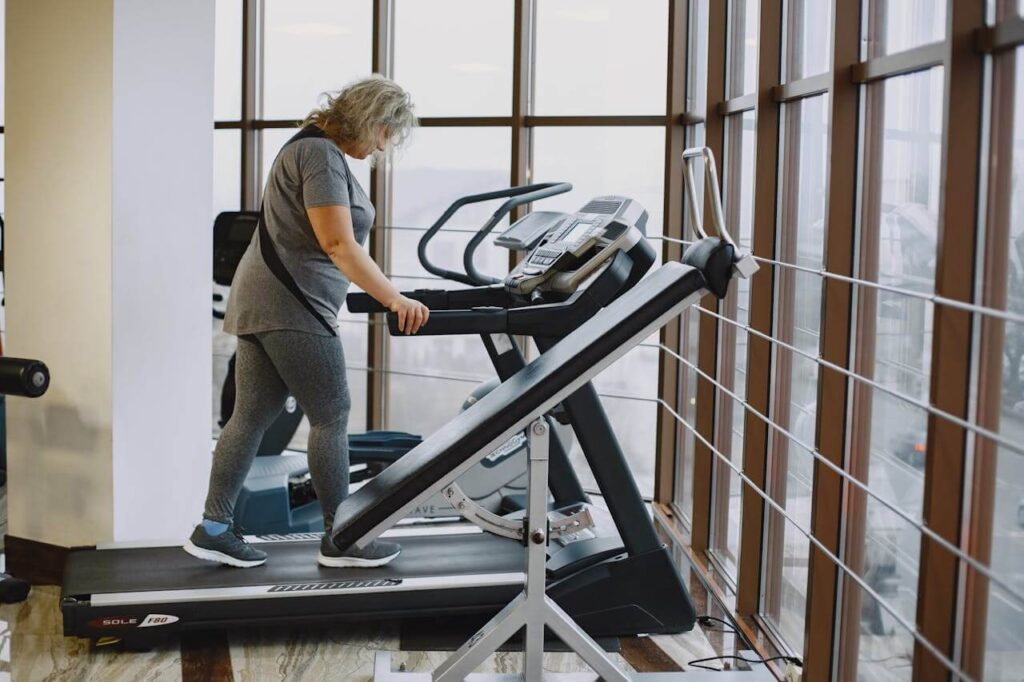
Handrails offer balance rather than support while running. Gripping them too tightly reduces the effectiveness of your workout and may cause strain in your shoulders and back. Instead, let your arms move naturally, just as they would when running outside.
Starting Too Fast Without Warming Up
Jumping into a quick run without warming up can catch your muscles off guard and increase the chance of injury. Always start each session with a 5–10 minute warm-up, like a slow walk or jog, to prepare your body for the exercise ahead.
Running with a Short, Uneven Stride
Many beginners might take short, choppy steps or overstride by extending their legs too far forward. This can cause discomfort and make running feel less efficient. Instead, focus on achieving a natural, steady stride in which your feet land comfortably under your body.
Skipping the Cooldown and Stretching
Abruptly stopping after a run may cause dizziness and muscle tightness. To enhance flexibility and minimize soreness, it’s important to gradually slow down with a 5-minute walk followed by stretching.
Beginner Treadmill Workout Plan
If you’re new to treadmill running, it’s important to start with a structured plan that helps you build endurance, improve your form, and avoid injury.
This is the workout plan I used when I was starting to run on a treadmill, which will gradually increase your running time while keeping things manageable.
Walk-Run Intervals (Week 1-2)
At this stage, your goal is to get used to the treadmill and develop a habit of moving consistently.
Start with a 5-minute brisk walk at a pace of 2.5–3.5 mph. For the workout, alternate between running for 30 seconds at 4.5–5.5 mph and walking for 2 minutes at 2.5–3.5 mph. Continue this cycle for 20–30 minutes. Finish with a 5-minute slow walk at 2.0–2.5 mph.
Increase Running Duration (Week 3-4)
As your body gets used to the routine, let’s gradually increase your running time while still enjoying those short walking breaks!
To get started, take a delightful 5-minute brisk walk to warm up your body. For the workout, alternate between 1 minute of running at a lively pace of 5.0–6.0 mph and 1 minute of a gentle walk at 2.5–3.5 mph. Keep this rhythm going for 20–30 minutes. To finish up, enjoy a relaxing 5-minute slow walk to cool down.
Running with Rest Intervals (Week 5+)
By this stage, you should feel more comfortable running for longer periods
Begin with a 5-minute brisk walk. Then, run for 5 to 10 minutes at a speed of 5.0 to 6.5 mph, walking for 1 to 2 minutes as needed. Repeat this cycle until you reach a total of 30 minutes. Finally, cool down with a 5-minute slow walk followed by stretching.
Read our: 15 Common Treadmill Mistakes and How To Avoid Them
Conclusion
Running on a treadmill is a fantastic way for beginners to boost endurance, enhance fitness, and stay on track with workouts. By following our helpful steps—starting with a warm-up, keeping good posture, using the incline wisely, and ensuring a proper cool down—you can make your treadmill running both safe and effective.
Avoid common mistakes, such as gripping the handrails or starting too quickly. Follow a structured beginner workout plan to gradually build your stamina. Staying motivated with music, tracking your progress, and setting achievable goals will help you stay on track.
Now that you know how to run on a treadmill as a beginner, it’s time to put these tips into practice. Begin at a slow pace, pay attention to your body, and remain consistent. With time, you’ll gain confidence and appreciate the many benefits of treadmill running.
How to Run on a Treadmill for Beginners (FAQs)
Is running on a treadmill good for beginners?
Yes, running on a treadmill is excellent for beginners. It offers a controlled environment, minimizes impact on the joints, and enables you to adjust the speed and incline according to your fitness level.
What is a good speed to start running on a treadmill?
New runners should begin at a walking speed of 2–3 mph and slowly progress to a light jog at 4–5 mph. After feeling at ease, you may increase your pace to 5–6 mph or higher based on your stamina.
How long should a beginner run on a treadmill?
Begin with 10 to 15 minutes of running, incorporating both a warm-up and a cooldown. As your endurance builds, extend your running time to 20 to 30 minutes.
How often should beginners run on a treadmill?
Target 3 to 4 sessions each week, ensuring rest days for recovery in between. As your endurance develops, you can raise the frequency.
Related Article: Best Treadmill For Seniors

